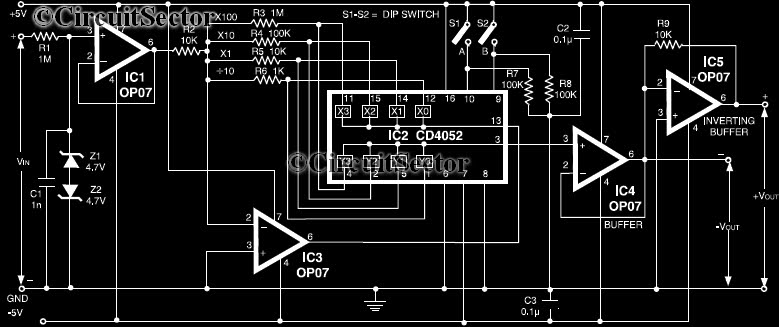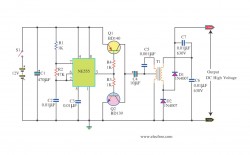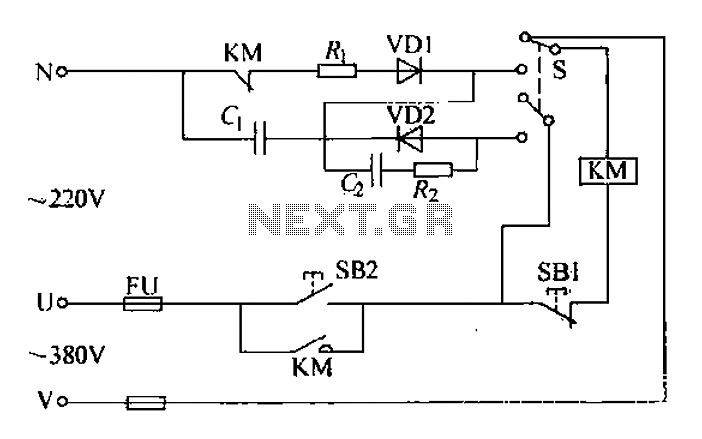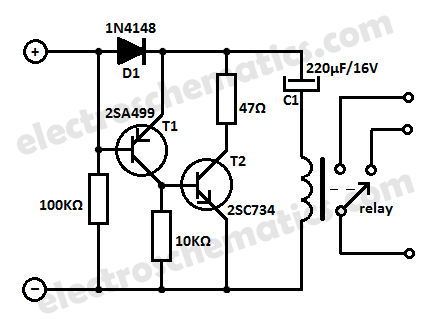
Voltage follower circuit

An AC-coupled unity gain voltage follower operating on a single supply is illustrated. The voltage divider network consisting of resistors R1 and R2 provides a DC voltage equal to half the supply voltage to the non-inverting input of the 741 operational amplifier. Consequently, the output DC voltage also remains at half the supply voltage, allowing the output signal to swing above and below this level. The standing DC voltage at pin 6 is not significant because the output is coupled to the subsequent stage through a capacitor. The input impedance is equal to the parallel combination of R1 and R2, which is 500K Ohms in this scenario. Due to the presence of 100% negative feedback, the output impedance is very low. For low-frequency applications, capacitors C1 and C2 can be substituted with larger value electrolytic capacitors.
The described circuit functions as a unity gain voltage follower, which is an essential configuration in analog electronics. The primary role of this circuit is to buffer signals, providing high input impedance while maintaining low output impedance. This characteristic is particularly useful when interfacing high-impedance sources with low-impedance loads, ensuring minimal signal loss and distortion.
The voltage divider formed by resistors R1 and R2 sets the reference level for the non-inverting input of the operational amplifier. By configuring R1 and R2 to equal values, the non-inverting input is held at half the supply voltage, which is critical for AC coupling as it allows the output to swing symmetrically around this midpoint. The operational amplifier (in this case, a 741) is configured with negative feedback, which stabilizes the gain at unity and minimizes distortion.
The coupling capacitors, C1 and C2, serve to block any DC component of the signal while allowing AC signals to pass through. This is crucial in applications where the DC offset must be eliminated to prevent saturation of subsequent stages. The choice of capacitor values can significantly influence the frequency response of the circuit; therefore, for low-frequency applications, larger electrolytic capacitors are advisable to ensure that the cutoff frequency remains well within the desired operational range.
The input impedance, calculated as 500K Ohms, indicates that the circuit will not load down the source, preserving signal integrity. The low output impedance, a result of the feedback mechanism, allows the circuit to drive subsequent stages effectively without significant voltage drop. This configuration is widely used in audio processing, sensor interfacing, and other applications where signal integrity is paramount.An AC coupled unity gain gain voltage follower operating on a single supply is shown here. The voltage divider network of R1 and R2 provides a DC voltage equal to half the supply voltage to the non-inverting input of the 741. The output DC voltage therefore stands at half the supply voltage. The output signal swings above and below this value. The sta nding DC voltage at pin 6 does not matter because the output is coupled to the next stage via a capacitor. The input impedance is equal to the value of R1 and R2 in parallel, i. e. 500K Ohms in this case. Because of hundred percent negative feedback, the output impedance is very low. For low frequency applications C1 and C2 can be replaced by electrolytic capacitors of large values. 🔗 External reference
The described circuit functions as a unity gain voltage follower, which is an essential configuration in analog electronics. The primary role of this circuit is to buffer signals, providing high input impedance while maintaining low output impedance. This characteristic is particularly useful when interfacing high-impedance sources with low-impedance loads, ensuring minimal signal loss and distortion.
The voltage divider formed by resistors R1 and R2 sets the reference level for the non-inverting input of the operational amplifier. By configuring R1 and R2 to equal values, the non-inverting input is held at half the supply voltage, which is critical for AC coupling as it allows the output to swing symmetrically around this midpoint. The operational amplifier (in this case, a 741) is configured with negative feedback, which stabilizes the gain at unity and minimizes distortion.
The coupling capacitors, C1 and C2, serve to block any DC component of the signal while allowing AC signals to pass through. This is crucial in applications where the DC offset must be eliminated to prevent saturation of subsequent stages. The choice of capacitor values can significantly influence the frequency response of the circuit; therefore, for low-frequency applications, larger electrolytic capacitors are advisable to ensure that the cutoff frequency remains well within the desired operational range.
The input impedance, calculated as 500K Ohms, indicates that the circuit will not load down the source, preserving signal integrity. The low output impedance, a result of the feedback mechanism, allows the circuit to drive subsequent stages effectively without significant voltage drop. This configuration is widely used in audio processing, sensor interfacing, and other applications where signal integrity is paramount.An AC coupled unity gain gain voltage follower operating on a single supply is shown here. The voltage divider network of R1 and R2 provides a DC voltage equal to half the supply voltage to the non-inverting input of the 741. The output DC voltage therefore stands at half the supply voltage. The output signal swings above and below this value. The sta nding DC voltage at pin 6 does not matter because the output is coupled to the next stage via a capacitor. The input impedance is equal to the value of R1 and R2 in parallel, i. e. 500K Ohms in this case. Because of hundred percent negative feedback, the output impedance is very low. For low frequency applications C1 and C2 can be replaced by electrolytic capacitors of large values. 🔗 External reference





